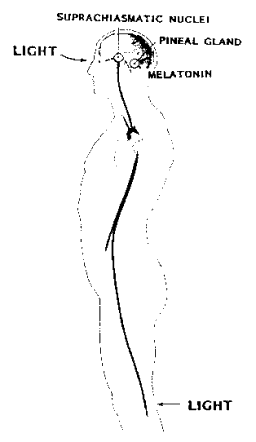 |
Science Frontiers ONLINE No. 116: Mar-Apr 1998 |
|
|
Eyeless Vision
Tomatoes see red. And other colors, too! We touched on this subject over a decade ago. (SF#54) Then we described how the use of red plastic mulch greatly improves the yields of tomato plants. More recent research reveals that fruit quality and resistance to pests are also improved. How can this be?
Plant leaves, it turns out, contain color sensors -- light-sensitive pigments similar to those it the human retina. Obviously, the plants do not "see," but the pigments provide environmental information. Here's the mechanism: plant leaves reflect infrared light well, so when a tomato plant's pigments detect a lot of infrared, the plant "thinks" that it may be crowded out by competing vegetation. The tomato plant responds aggressively by growing more rapidly.
The red plastic mulch between the rows also reflects a lot of infrared light, and it thereby tricks the tomato plant into accelerating its growth.
(Raloff, Janet; "When Tomatoes See Red," Science News, 152:376, 1997.)
Fire-detecting beetles. The beetle Melanophila acuminata seeks out forests that have just been ravaged by fires so that it can lay its eggs in the nutritious, freshly burnt wood. These insects are capable of detecting fires up to 32 kilometers (20 miles) distant. They do not see the fire with their eyes but instead detect the thermal (infrared) radiation with a special organ on their chests.
(Schmitz, Helmut, et al; "Infrared Detection in a Beetle," Nature, 386:773, 1997.)
Knees "see". Well, sort of, and then only the backs of the knees. Human circadian clocks can be shifted by shining visible light on the skin on the backs of the knees. It is theorized that the light penetrates the skin and causes chemical changes in the blood, implying that human blood contains "chronobiological photoreceptors."
(Oren, Dan A., and Terman, Michael; "Tweaking the Human Circadian Clock with Light," Science, 279:333, 1998. Also: Campbell, Scott S., and Murphy, Patricia J.; "Extraocular Circadian Phototransduction in Humans," Science, 279:396, 1998.)
Comment. We can see how the tomatoes and beetles might find exotic photoreceptors useful, but what environmental pressures would favor the evolution of photoreceptors in the human blood?
 | Our circadian clock can be reset by light through the eyes or light shining on the backs of knees. |